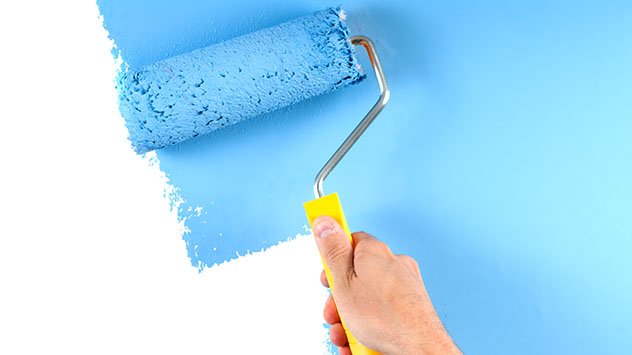
Which Type of Paint is Best for Interior Walls?
Which Type of Paint is Best for Interior Walls?
When it comes to choosing interior wall paint, our focus is usually on the shade or finish of wall paints. We rarely go into the details- be it texture or composition. But if you want to choose the best paint for your beloved home, you must understand how one type of paint differs fundamentally from the other. Each type of paint comes with a unique set of function and properties, meant for a specific purpose.
If you’re planning to upgrade the look of your home with a fresh coat of paint, take a look at five different types of paint for interior walls before you commit:
Emulsion paint
Emulsion paints are water-based, making them almost odour-less and the most preferred choice for interior wall paint colours. The paint is quick drying and has a very low level of VOCs (volatile organic compounds). Moreover, emulsion paints are durable and washable so you can easily remove stains using a wet cloth or mild soap solution. It is also available in a variety of finishes like sheen, silk and matte and makes a great choice if you are planning to paint your home walls.
advantage
Emulsion paint is quick-drying, with a very low level of VOCs (volatile organic compounds).
The paint is available in various finishes, such as matte, satin and silk.
The paint is extremely durable and long-lasting.
Emulsion paint is washable, and stains can be removed by simply wiping the surface with a damp cloth dipped in water or a mild soap solution.
It is resistant to fungus and mildew.
Another plus is that emulsion paints contain non-yellowing agents, which ensures good stability of colours that do not fade in the presence of sunlight.
The paint is acrylic based, which makes the paint elastic and highly resistant to cracking.
disadvantage
Emulsion paints require a coat of primer before application of the paint.
Another drawback is that the glossy finishes of emulsion paint show up all the imperfections and undulations of the walls.
Ideal for: High traffic areas like doorways and hallways and prone to get messy rooms like the kitchen, bathroom, study room and kids’ room.
Enamel paint
Enamel paint is usually used to coat metallic and wooden finishes/surfaces. It has a hard, glossy and opaque finish. It can also be painted on walls to protect them from tough conditions. For example, for commercial kitchens, enamel paint is a good choice since it is resistant to water, stain and heat. Bathroom doors that are exposed to moisture can also be painted with enamel paint.
advantage
Enamel paint is highly durable.
It is glossy, which imparts a rich finish to the walls.
Enamel paint is best suited for areas that are subject to high moisture and humidity.
disadvantage
One disadvantage is that enamel paint is less flexible in comparison to emulsion paint. It may develop cracks over a period of time.
Enamel paint takes a longer time to dry.
Another minus is that this paint emits strong odours, which may also be harmful to health.
Solvents such as turpentine are required to clean the paint brushes.
Ideal for: All indoor and outdoor wood and metal surfaces.
Textured paint
Textured paint offers a great aesthetic value, perfect to create a hint of accent on the walls. It can be used to create special effects on the wall, be it marble, stucco, sand swirl and popcorn texture for interior wall painting designs. This paint is a great way to hide minor flaws and inconsistencies on the walls. Textured paint is difficult to work with and only expert painters can do a good job with it.
advantage
Textured paint can impart a rustic look to the accent wall or create the effect of marble, stucco and so on.
Textured paint is usually thicker than the other conventional types of paint.
This paint is a great way to cover minor defects such as an uneven or damaged wall or even wall cracks.
disadvantage
Textured paint is comparatively more expensive than the other conventional types of paint.
Once the surface of the textured paint is damaged, it becomes very difficult to touch up the surface in precisely the same colour or texture. There is likely to be a slight colour variation.
Only expert painters can work with textured paint.
Ideal for: Accent walls in any room and walls with minor flaws and inconsistencies.
Distemper paint
The usage of distemper paint goes way back, as far as ancient Egypt. The paint has however evolved with time and available in different varieties. It is also known as whitewash or cement paint and can be applied directly on the plastered surface without the use of any primer. If applied on the surface before painting, it can help other paints last for a longer period of time. This type of paint does not crack or fade in the presence of sunlight.
Ideal for:The balcony, terrace and roof and industrial use.
Metallic paint
Metallic paint, as the name suggests, contains tiny particles of metal such as bronze, steel, copper or aluminium. It can work as a great alternative to wallpaper for an accent wall, making any room look more luxurious and opulent. Moreover, it can also be used.
advantage
This type of paint has a metallic finish which imparts a high-look luxurious look to the space.
Metallic paint works as a great alternative to wallpaper.
disadvantage
These paints are very expensive, but, on the other hand, it takes only a small section of wall painted with metallic paint to create a stunning effect.


Leave a Reply